A NIC report developed to provide timely insights from owners and C-suite operators and executives on the pulse of seniors housing and skilled nursing sectors.
NIC’s Executive Survey of operators in seniors housing and skilled nursing is designed to deliver transparency into market fundamentals in the seniors housing and care space at a time where market conditions are rapidly changing—providing both capital providers and capital seekers with data as to how COVID-19 is impacting the space, helping leaders make informed decisions.
This Wave 9 survey sample includes responses collected June 22-July 5, 2020 from owners and executives of 85 seniors housing and skilled nursing operators from across the nation. Detailed reports for each “wave” of the survey can be found on the NIC COVID-19 Resource Center webpage under Executive Survey Insights.
Wave 9 Summary of Insights and Findings
Pent-up resident/family demand and the easing of COVID-19 related move-in restrictions (either organization-imposed or government-imposed) freeing up the backlog of pre-pandemic planned move-ins are resulting in larger shares of organizations reporting month over month and week over week improvements in occupancy rates than in all prior waves of the survey.
The shares of seniors housing and care organizations reporting an acceleration in move-ins in the past 30-days—across each of the care segments—is the highest in the time series (March 24 to July 5, 2020), while the shares of organizations reporting deceleration in move-ins is the lowest. In addition to bans on move-ins abating, survey respondents commented that resumption of pre-COVID-19 planned resident move-ins, increased availability of COVID-19 testing prior to entry, and lessons learned regarding sanitation measures and enhanced safety protocols for visiting with social distancing has resulted in growing reassurance about moving into seniors housing. Organizations citing resident/family member concerns about entering seniors housing and care is at the lowest level in the survey time series (38%).
It is important to note that while most Wave 9 metrics indicate more favorable occupancy trends compared to previous survey waves, the survey data is relative to post-pandemic metrics 30-days ago, not relative to pre-pandemic metrics.
- In Wave 9, the share of organizations reporting an acceleration in move-ins improved, and the share of organizations reporting no change in move-outs increased across all care segments. Between 36% and 42% of organizations reporting on their independent living, assisted living, memory care, and nursing care segments indicated that the pace of move-ins accelerated in the past 30-days. This is the second consecutive wave showing an increase of organizations reporting accelerated move-ins in the past 30-days.
- As a result, the largest share of Wave 9 survey respondents reported occupancy improvement across all care segments since the survey began. Approximately 80% of organizations with memory care units, 70% of organizations with independent living units, approximately 60% of organizations with nursing care beds and approximately 45% of organizations with assisted living units report an increase or no change in occupancy rates from one-month prior in Wave 9, compared to approximately 50% (MC), 45% (IL) , 40% (NC) and 50% (AL) in Wave 8 (note: while the assisted living care segment had a higher share of organizations reporting occupancy increases in Wave 9, more in Wave 8 reported no change).
- The nursing care segment in Wave 9 shows the highest share of organizations relative to other care segments reporting increases in occupancy (42%), presumably caused by elective surgeries having resumed in certain geographies. Assisted living leads the other care segments in terms of organizations reporting month-over-month declines in occupancy rates (57%).
- Regarding the change in occupancy from one week ago—while each of the care segments show the smallest shares of organizations reporting occupancy declines since the survey began—organizations with the highest levels of acuity (memory care and nursing care)—report the most occupancy improvement from one week earlier (34% and 29%, respectively).
- About one in ten organizations report that it is still very difficult to obtain enough PPE/testing kits in most markets. Access to PPE and COVID-19 test kits picked up in Wave 9 compared to Wave 8, however. More than one in three organizations note that access to PPE and COVID-19 test kits improved considerably in Wave 9, compared to approximately one in four organizations responding similarly in Wave 8.
- While Wave 9 shows improvement in the market fundamentals compared to previous surveys, there may be indication of potential impending negative impact on move-in rates due to accelerating cases of COVID-19 contagion in areas of the sunbelt and other hot spot locales across the country: fewer organizations indicated they would end move-in restrictions within one month, compared to Wave 8. Half of organizations in Wave 9 (50%) compared to one-third of organizations in Wave 8 (32%) indicate they will wait a month or longer to lift move-in restrictions.
Wave 9 Survey Demographics
- Responses were collected June 22-July 5, 2020 from owners and executives of 85 seniors housing and skilled nursing operators from across the nation.
- More than half of respondents are exclusively for-profit providers (59%), about one-third (30%) are exclusively nonprofit providers, and 11% operate both for-profit and nonprofit seniors housing and care organizations.
- Owner/operators with 1 to 10 properties comprise 55% of the sample. Operators with 11 to 25 properties make up 24% while operators with 26 properties or more make up 21% of the sample.
- Many respondents in the sample report operating combinations of property types. Across their entire portfolios of properties, 78% of the organizations operate seniors housing properties (IL, AL, MC), 30% operate nursing care properties, and 33% operate CCRCs (aka Life Plan Communities).
Key Survey Results
Pace of Move-Ins and Move-Outs
Respondents were asked: “Considering my organization’s entire portfolio of properties, overall, the pace of move-ins and move-outs by care segment in the past 30-days has…”
-
- The shares of organizations reporting an acceleration in move-ins in the past 30-days—across each of the care segments—is the highest in the time series (March 24 to July 5, 2020), while the shares of organizations reporting deceleration in move-ins is the lowest.
- In Wave 9 of the survey, between 36% and 42% of organizations reporting on their independent living, assisted living, memory care, and nursing care segments indicated that the pace of move-ins accelerated in the past 30-days.
- Comparatively, between 16% to 26% of organizations with independent living, assisted living and/or memory care segments, and 33% of organizations with nursing care beds indicated that the pace of move-ins decelerated in the past 30-days—the smallest shares reported in the time series.
- The independent living care segment saw the most growth in the shares of organizations reporting an acceleration in move-ins between Wave 8 and Wave 9 (from 19% to 42%).
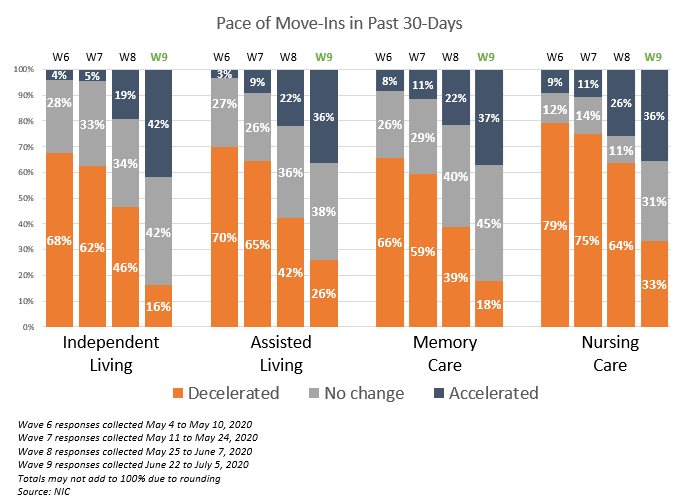
Reasons for Deceleration/Acceleration in Move-Ins
Respondents were asked: “The deceleration/acceleration in move-ins is due to…”
-
- In Wave 9 of the survey—as some state and local governments lifted COVID-19 contagion spread mitigation measures—the fewest respondents since the survey’s inception cited an organization-imposed ban (38%), a government-imposed ban (13%), or resident or family member concerns (38%) as reasons for slumping move-in rates.
- In each of the past three waves of the survey, roughly three-quarters of organizations cited increased resident demand (many due to pre-COVID-19 planned move-ins resuming) as a reason for acceleration in move-ins. Conversely, the primary reason cited for deceleration in move-ins continues to be slow leads conversions/sales.
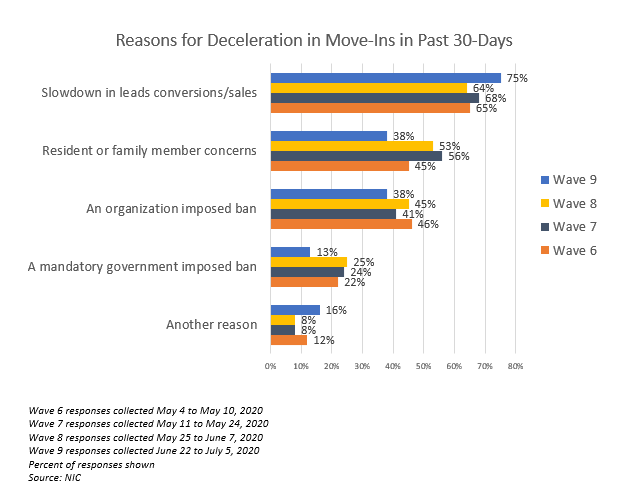
Time Frame for Lifting Restrictions on Move-Ins
Respondents that reported having an organization-wide ban or mandatory government-imposed ban were asked: “My organization anticipates lifting restrictions on settling new residents into some or all of our communities…”
-
- In Wave 9 of the survey, fewer organizations indicated they would end move-in restrictions within one month, compared Wave 8.
- Perhaps due to increased COVID-19 activity across the country, or a trait of this survey sample, half of organizations in Wave 9 (50%) compared to approximately one-third of organizations in Wave 8 (32%) indicate they will wait a month or longer to lift move-in restrictions.
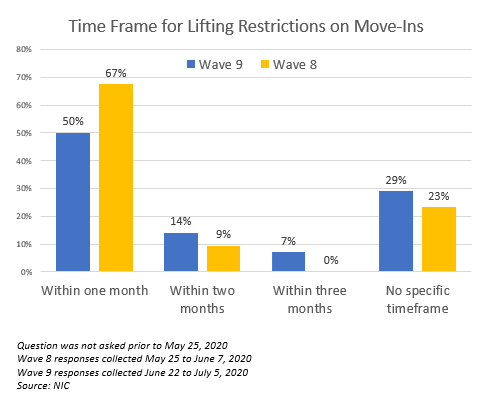
Move-Outs
-
- The share of organizations reporting no change in the pace of move-outs is improving. Approximately three-quarters of organizations with independent living and/or memory care units (76% and 74%), and roughly two-thirds of organizations with assisted living units and/or nursing care beds (65% and 69%) note no change in the pace of move-outs in the past 30-days.
- In Wave 9, while the shares of organizations with memory care units reporting an acceleration in move-outs has steadily declined, the shares of organizations with assisted living units reporting an acceleration has been above 20% since Wave 4 (April 20-April 26, 2020).
- The shares of organizations reporting a deceleration in move-outs in the independent living and nursing care segments are the smallest since the beginning of the survey.
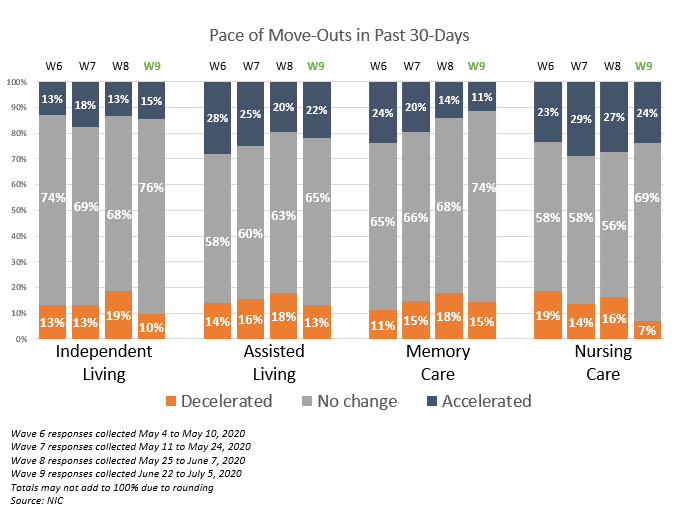
Change in Occupancy by Care Segment
Respondents were asked: “Considering the entire portfolio of properties, overall, my organization’s occupancy rates by care segment are… (Most Recent Occupancy, Occupancy One Month Ago, Occupancy One Week Ago, Percent 0-100)”
-
- In Wave 9, the largest shares of survey respondents reported occupancy improvement across all care segments since the survey began. Approximately 80% of organizations with memory care units, 70% of organizations with independent living units, approximately 60% of organizations with nursing care beds and approximately 45% of organizations with assisted living units report an increase or no change in occupancy rates from one-month prior in Wave 9, compared to approximately 50% (MC), 45% (IL), 40% (NC), and 50% (AL) in Wave 8 (note: while the assisted living care segment had a higher share of organizations reporting occupancy increases in Wave 9, more in Wave 8 reported no change).
- However, assisted living leads the other care segments in terms of organizations reporting month-over-month declines in occupancy rates (57%).

-
-
- The chart below shows the time series progression of shares of organizations reporting an increase in occupancy rates from one-month prior. The nursing care segment in Wave 9 shows the highest shares of organizations reporting occupancy increases relative to other segments (42%).
-
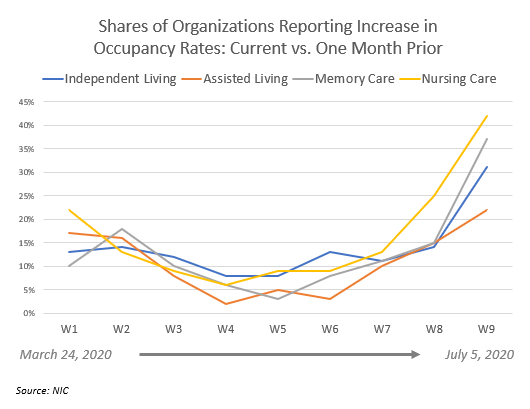
-
-
- Regarding the change in occupancy from one week ago—while each of the care segments show the smallest shares of organizations reporting occupancy declines since the survey began—organizations with the highest levels of acuity (memory care and nursing care)—report the most occupancy improvement) from one week earlier (34% and 29%, respectively).
-

-
- Improvement in Access to PPE and COVID-19 Testing Kits
Respondents were asked: “Considering access to PPE (personal protective equipment) and COVID-19 testing kits, my organization has experienced that access has improved… Very little, it is still difficult to obtain enough PPE/testing kits in most markets/Somewhat, in some markets it is easier to obtain PPE/testing kits than in others/Considerably, we typically have no difficulty obtaining PPE/testing kits, regardless of market”
-
-
- About one in ten organizations report that it is still very difficult to obtain enough PPE/testing kits in most markets.
However, access to PPE and COVID-19 test kits improved wave over wave. More than one in three organizations indicate that access to PPE and COVID-19 test kits increased considerably in Wave 9, compared to approximately one in four organizations responding similarly in Wave 8.
- About one in ten organizations report that it is still very difficult to obtain enough PPE/testing kits in most markets.
-
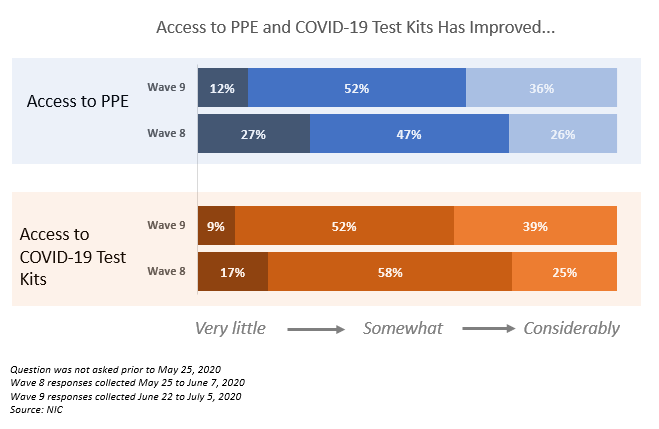
NIC wishes to thank survey respondents for their valuable input and continuing support for this effort to bring clarity and transparency into market fundamentals in the seniors housing and care space at a time where trends are rapidly changing. NIC also thanks both ASHA and Argentum for their support in encouraging participation in the Executive Survey Insights: COVID-19 survey. The results of our joint efforts to provide timely and informative data to the market in this challenging time have been significant and noteworthy. The Executive Survey Insights: COVID-19 survey is now open. To respond to the survey, please click here.
If you are an owner or C-suite executive of seniors housing and care properties and have not received an email invitation but would like to participate in the upcoming Executive Survey: Market Fundamentals (which will start again on Monday, July 20), please send a message to insight@nic.org to be added to the email distribution list.
